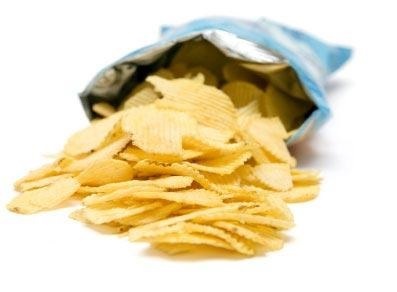It was a hot, muggy, August afternoon in Washington. The sweltering heat led me down to the Georgetown campus store where they sell soft drinks, smoothies, and snacks. As I scanned the shelves, something caught my eye. "Share a Coke with Nathan."
There seems to be a new trend in food labels, with more and more products featuring some reminder on the packaging about sharing. It got us at the Georgetown Institute for Consumer Research wondering about whether these labels have any effect on our behavior. Are we more likely to buy something if it features a reminder about sharing?
We decided to investigate this with a simple experiment. We gave participants a scenario: You're out shopping and you come across "an appealing bag of chips." Below this was the following image:
The participants were then divided into three groups, with each group seeing slightly different information below the picture of the bag of chips:
- The no-label group saw just the bag of chips with no additional information.
- The sharing-size group saw an additional sentence at the bottom that stated, "The package label says that the bag is "Sharing Size."
- The king-size group saw another version where the sentence at the bottom informed participants that the package label was "King Size." This was done in order to account for the possibility that the sharing-size group might infer that the bag contained more chips than the no-label group.
When the bag was described as "sharing size", people were more likely to purchase the chips! I call this the sharing size boost (the difference in purchase likelihood between the no-label and sharing-size groups). Note that this effect is not occurring merely because the sharing-size group thought they were getting more. We know this because the numbers are lower for "King Size", a label that also indicates you're getting a larger quantity. Moreover, participants in the sharing-size group reported feeling much lower levels of guilt than the participants in the no-label and king-size groups who reported feeling (similar) higher levels of guilt.
This suggests that perhaps a sharing reminder helps people to justify their purchase and feel less guilty about what they're buying. You can almost hear them thinking, "It's okay! I'm not going to eat all this by myself! I'm going to share this!"
These data imply that a sharing reminder does seem to lead to greater likelihood of purchasing. But does this happen to the same extent for everyone? I suspected that women would be generally less likely to purchase the chips compared to men. So would the different labels impact the likelihood of purchase for men and women differently?
Indeed, women were less likely to purchase the chips than men when there was no label present. Adding the "king size" label helped somewhat, with women slightly more likely to purchase. However, the "sharing size" label seemed to have a big impact on women. The boost was 20% for women compared to 9% for men! The guilt ratings were also in line with this. Women reported feeling more guilty than men across the board, but particularly so when there was no label or the "king size" label. However, women who saw the "sharing size" label reported levels of guilt that were much closer to the men who saw the same label. Thus, it would seem that the "sharing size" label helped women to justify the purchase, and feel much less guilty about buying a bag of chips.
These data raise two questions. First, are the people opting for a sharing-size package actually sharing what they buy with someone else? We don't have an answer to that because this study used a hypothetical scenario. But let me know in the comments if you do or don't share when you buy something with a sharing reminder on the packaging! Second, would sharing reminders work just as well for other things? We ran the experiment using a bag of chips; perhaps not the healthiest thing one could be buying. But picture a bag of kale that says "enjoy with friends and family," or one of those small (so-called personal) watermelons at the grocery store inviting you to "share with someone you love." Would a sharing reminder make you more likely to purchase them?
While you ponder that, I'm going to go share my Coke with Nathan.
Have a question about consumer behavior that you'd like answered? Click here to submit your question.
The Georgetown Institute for Consumer Research receives funding from KPMG. However, research activities are determined by the interests of the Institute's researchers and trending topics.
